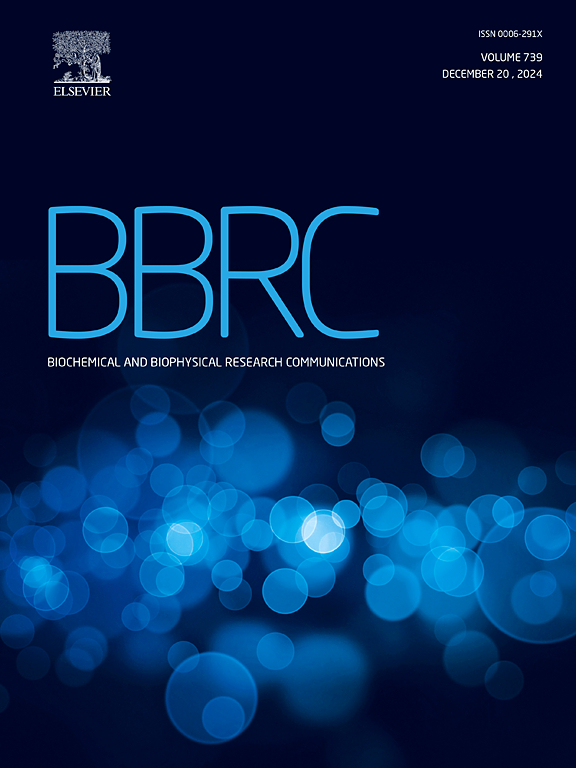Elevated circulating HHIP levels in patients with metabolic syndrome
IF 2.5
3区 生物学
Q3 BIOCHEMISTRY & MOLECULAR BIOLOGY
Biochemical and biophysical research communications
Pub Date : 2024-10-23
DOI:10.1016/j.bbrc.2024.150877
引用次数: 0
Abstract
Abnormal fat accumulation can lead to metabolic syndrome (MetS), increasing the risk of diabetes and cardiovascular disease in MetS patients. Early identification of MetS risk is essential for effective disease prevention. Using bioinformatics methods, we sought biomarkers for MetS. After analyzing the GSE9624 and GSE15524 datasets, we identified three commonly differentially expressed genes: COX7A1, PRR12, and HHIP. Subsequently, we validated the expression of these DEGs using the GSE65540 dataset. Quantitative PCR and immunoblotting confirmed significantly elevated HHIP expression in the adipose tissue of HFD-fed and ob/ob mice. Furthermore, a population-based cohort study demonstrated that serum HHIP levels were significantly greater in MetS patients than in healthy controls and were correlated with all MetS components. Receiver operating characteristic (ROC) curve analysis confirmed the robust predictive capacity of HHIP levels for metabolic syndrome, with an area under the curve (AUC) of 0.72 (95 % confidence interval: 0.68–0.78, P < 0.001). Binary logistic regression showed that the serum HHIP concentration was significantly associated with MetS even after adjusting for anthropometric and lipid profile variables. In conclusion, our findings demonstrate that changes in HHIP expression are significantly associated with adverse MetS indicators, indicating that HHIP can serve as a new biomarker for the diagnosis of MetS.
代谢综合征患者体内循环 HHIP 水平升高
异常脂肪堆积会导致代谢综合征(MetS),增加代谢综合征患者罹患糖尿病和心血管疾病的风险。及早识别 MetS 风险对于有效预防疾病至关重要。我们利用生物信息学方法寻找 MetS 的生物标志物。在对 GSE9624 和 GSE15524 数据集进行分析后,我们发现了三个常见的差异表达基因:COX7A1、PRR12 和 HHIP。随后,我们利用 GSE65540 数据集验证了这些 DEGs 的表达。定量 PCR 和免疫印迹证实,HFD 喂养和肥胖/肥胖小鼠脂肪组织中的 HHIP 表达明显升高。此外,一项基于人群的队列研究表明,MetS 患者的血清 HHIP 水平明显高于健康对照组,并且与 MetS 的所有成分相关。接收者操作特征曲线(ROC)分析证实,HHIP 水平对代谢综合征具有很强的预测能力,曲线下面积(AUC)为 0.72(95 % 置信区间:0.68-0.78,P < 0.001)。二元逻辑回归显示,即使调整了人体测量和血脂特征变量,血清 HHIP 浓度仍与 MetS 显著相关。总之,我们的研究结果表明,HHIP表达的变化与不良MetS指标显著相关,这表明HHIP可作为诊断MetS的新生物标记物。
本文章由计算机程序翻译,如有差异,请以英文原文为准。
求助全文
约1分钟内获得全文
求助全文
来源期刊
CiteScore
6.10
自引率
0.00%
发文量
1400
审稿时长
14 days
期刊介绍:
Biochemical and Biophysical Research Communications is the premier international journal devoted to the very rapid dissemination of timely and significant experimental results in diverse fields of biological research. The development of the "Breakthroughs and Views" section brings the minireview format to the journal, and issues often contain collections of special interest manuscripts. BBRC is published weekly (52 issues/year).Research Areas now include: Biochemistry; biophysics; cell biology; developmental biology; immunology
; molecular biology; neurobiology; plant biology and proteomics

 求助内容:
求助内容: 应助结果提醒方式:
应助结果提醒方式:


